This is the fifth article in a series of articles about the Trait system in Lord of the Rings Online. This article covers Class based Traits. You can check out the previous articles here – 1, 2, 3, 4 or on the articles page.
Introduction
Of all the Traits in the Lord of the Rings Online system, Class Traits are the most numerous. As the name suggests, they are all unique on a per class basis, and there are many of them to choose from. More than any other Trait, Class Traits will affect how your character performs in nearly all combat situations. They change skills, improve effects, remove or replace abilities and generally have a profound impact on what your character can achieve.
Since there are so many of them, this article is not going to cover them all in any specific detail. Instead it will focus on the general system, the Class Trait sets introduced in the Moria expansion and the bonuses they bring, and provide resources where you can find out more about what Traits your favourite character gets.
Gaining Class Traits
Earning Class Traits is the same for every class, and every Trait. From level 15 upwards, using various class skills will trigger a new Deed. That Deed will require you to use the same skill a certain number of times, at the end of that process you will earn the particular Class Trait as a reward. Not all skills trigger Deeds at the same time, and since skills are earned at varying levels, you’ll earn the Class Traits at different rates as well. Also, not all the Deeds are equally difficult and many are affected by play style. For example, you may use Quick Thrust 50 times in a fight but use Shield Bash once per day, and as a result, you’re going to earn Deeds at different rates. The intent I believe is to emulate improving your character in-line with those skills you use most often. However, it doesn’t always work out that neatly because some underused skills are much improved by their Deeds so while you would not normally use them, you are eager to do so to gain the improved version.
The following image shows the Deed window open at the list of Class Traits, the progress of one of those Traits and details about how many uses are still required to complete the Deed.
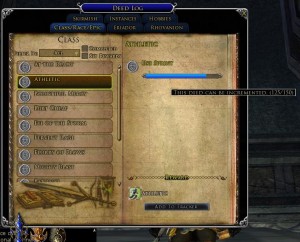
The number of times a skill can be used each day in order to progress a Class Trait Deed varies, and is usually based on the skill cool-down and whether it needs to be used in combat or not. Non-combat skills tend to have a smaller use per day limit (5, 10 or 15 for example), while combat related skills that refresh quickly tend to be much higher (in the hundreds). The number of times you must use the skill to complete the Deed also varies and can be in the low 10’s to 2000 or more. For some skills you use all the time this won’t be an issue, but for other skills you’ll have to remind yourself to do something about using them, and as you can see above, you can add the Deed progress to your quest tracker sidebar as a reminder.
It is generally true that combat skills must be used on enemies which return experience points in order to qualify as having successfully used them to progress the Deed, and likewise, if you use a skill and miss, it may not count (usually skill dependant).
As you can imagine, all this adds up to mean that progressing Class Trait based Deeds can be very time consuming and something you need to work at, rather than just happening by default. It also means you could still be working on them well beyond level 50.
Equipping Class Traits
Class Traits are equipped in the same way all Traits are, by visiting a Bard. You’ll see the same dialog, and you simply select the Class Traits you have available from the left, as shown in the screenshot below.
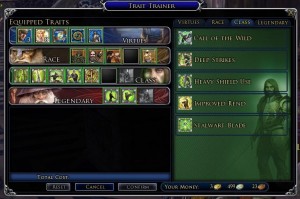
Viewing Class Traits
Class Traits are viewed using the regular Trait dialog, but there is an added element of complexity since the release of the Mines of Moria – Class Trait sets. Each Class Trait belongs to one of three different sets, the process is covered in more detail in the next section, but it results in there being three screens to look at when viewing your Class Traits.
At the opening screen of the Trait dialog, you can see your class Traits and on the right side all the bonuses you have earned (more on bonuses later), this is shown in the following screenshot.
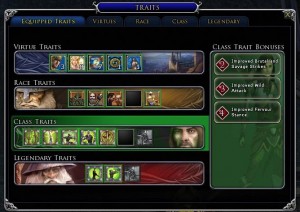
Once you click on the ‘Class’ tab in the dialog, there is a further tab at the bottom of the dialog which selects which of the Trait sets you are viewing. An example of a single classes set of Traits is shown below (click on each image for a larger version).
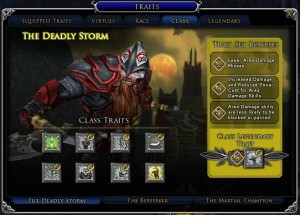
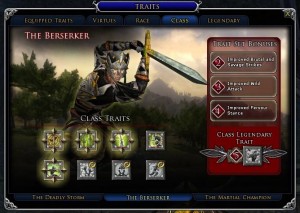

The icons in the Class Trait section are similar to the Virtue section. A diamond on each edge means the Trait is equipped. A coloured icon with no diamonds means the Trait has been earned but is not equipped. A light grey icon with a ring means that a Deed is in progress to earn this Trait but is not yet complete, and a grey icon with no ring means that no progress is being made to earn this Trait.
On the right of the dialog you will see a list of bonuses, they are explained in more detail in the next section.
Class Trait Sets
Prior to the Mines of Moria expansion, classes had a single list of Traits. Sometimes they complimented each other, and in some ways groups of them directed the character towards certain roles. With Moria, this was formalised into three sets for each class. There is no requirement to only use Traits from a specific set, however, there are incentives to do so. Each set is designed to give a character a certain focus, for example with Guardians there is a Trait set for generating more hate, a Trait set for doing damage with two-handed weapons and a Trait set for lasting longer in fights with single large enemies. Each set has a name and a brief description which you can read.
Within each set, the Traits are geared towards the stated aim of that set, although it’s not always entirely obvious why some Traits are included (however since the Traits existed before the sets, there’s probably a few they just had to find homes for). As mentioned, you are not penalised for picking Traits from a mix of sets, and it’s a valid approach to get the customisations you want.
However, if you do pick Traits from within a single set, the more you equip, the better the resulting set bonus is, and eventually, you earn the chance to equip a set specific Legendary Trait. That list of bonuses are shown on the right side of the Class Trait window, as shown in the previous section.
Each set provides a minor bonus with 2 Traits equipped, better bonuses at 3, the best bonuses at 4 and with 5 equipped you get an additionally Legendary Trait which you may then use. You do get all the bonuses you are eligible for, so picking two Traits from one set and three from another gives you two different sets of bonuses. Changing your equipped Traits later will change the bonus and if you become ineligible for the Legendary Trait then you will no longer be able to use it.
The following screenshots show a Champion class Trait window. Hovering over an equipped Trait in a set shows you any bonuses in effect. The first shows a Trait from a set with only one Trait equipped (no bonuses) and the second from a set with 5 Traits equipped (all bonuses).
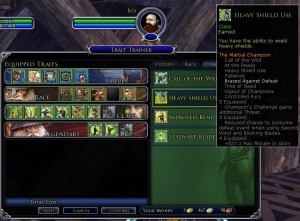

As well as being listed when you hover over skills, the bonuses in effect are listed in the basic Trait dialog. This is a repeat of the dialog shown earlier, on the right-hand side you can see the three bonuses that are in effect due to having 4+ Traits equipped from the same set, and no more than 1 from any other set (in this case).

It is well worth taking the time to understand the three different sets, what they mean for your character and which Traits you need to earn to achieve them. It is not cheap to move Class Traits around, but it is one area that might support different play styles (solo vs grouped for example).
Summary
Class Traits provides the greatest and most visible customisations of your character. They are the Trait above all other Traits that affect everything your character does. They can totally change the way in which your character behaves during different kinds of combat and let you focus on the play style you enjoy most.
You can find out more about your Class Traits over at the Lotro Wiki, and you can check out information on Trait Sets (and all the Class Traits in them) at the Lotro Lorebook.








